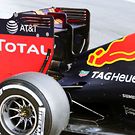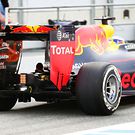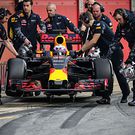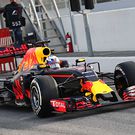Ininiti Red Bull RB11 Renault
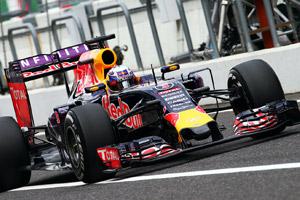
Active: 2015
Team: Red Bull Racing
Team: Adrian Newey (CTO), Rob Marshall (CD), Dan Fellows (HA), Christian Horner (TP), Pierre Wache (CE)
Drivers: Daniel Ricciardo (3), Daniil Kvyat (26)
Team name: Infiniti Red Bull Racing
The Red Bull RB11 was designed by Adrian Newey, but contrary to many of his previous Red Bulls, would turn out to be a car unable to win races. This however was largely due to the lack of performance in the Renault power unit, something that led into both parties blaming each other publicly throughout the season.
The car was presented on 1 February at Circuit de Jerez, just ahead of the first winter test that was kicking off there. It uniquely featured a camouflage livery during pre-season testing and therefore became the talk of the week, not least because viewers believed that was designed to hide some specific car design details.
As early as the first testing days, it was clear that the Renault unit was in trouble. Being primarily focused on Red Bull as their main customer, Renault had planned an aggressive series of updates to be testing in winter testing, aware that it was lagging behind in 2014. The plan backfired badly however, with insistent reliability issues requiring the French manufacturer to fix these first. Red Bull meanwhile were limited in pre-season running, holding back their own chassis development as well. Problems were further compounded by Daniil Kvyat who hit the barriers during the first week of testing, and had to complete the remainder of the day without a front wing as the team didn't have a spare at that time.

At the start of the season, expectations - or the lack thereof - were confirmed, and by the Spanish Grand Prix, the 5th event of the season, Daniel Ricciardo was already using his 4th engine, having had three catastrophic failure in the first 4 events - with just 4 engines per driver available that season, he soon started to amass grid penalties for taking new engines beyond the allowed 4. It was also at the Spanish Grand Prix where Red Bull introduced a shorter nose cone that failed to bring a major step forward. The disappointment of finishing a lap down with both cars there triggered team principal Christian Horner to say the team would have to start looking at the 2016 season.
Further updates came through in the next races, up until the Singapore Grand Prix, where Ricciardo was quoted as saying that the team's main issue was now the Renault engine, and that Red Bull Racing had managed to overcome most of its chassis deficiencies in the races before that point.
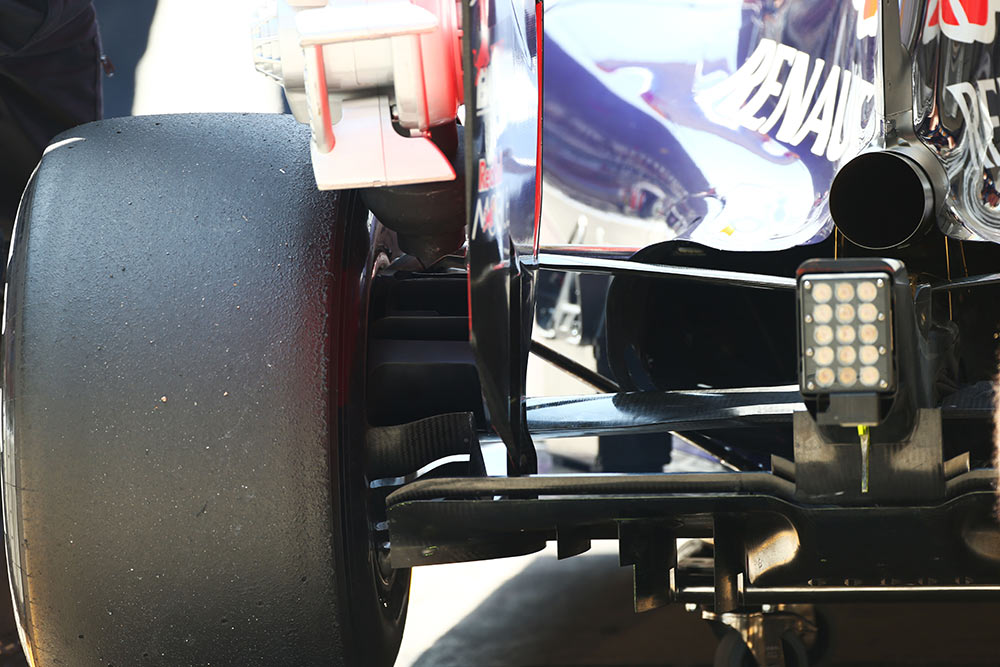
Overall, it was a disappointing campaign for Red Bull Racing, and the first without a victory since 2008. The highlights of the season were a second place finish in Hungary for Daniil Kvyat, and one for Ricciardo at the Singapore GP. The team limped to 4th in the Constructors' Championship, behind Mercedes, Ferrari and Williams, and had lots to do to repair their relationship with Renault, who at the end of the season were preparing to take over the financially struggling Lotus F1 Team, judging it a better marketing strategy compared to being an engine supplier.
Specifications
Chassis: Composite monocoque structure, designed and built in-house, carrying the Renault V6 as fully stressed member
Wheels: OZ Racing (Front: 12.0in x 13in diam., Rear: 13.7in x 13in diam.)
Tyres: Pirelli
Front suspension: Aluminium alloy uprights, carbon-composite double wishbone with springs and anti-roll bar, Multimatic dampers
Rear suspension: Aluminium alloy uprights, carbon-composite double wishbone with springs and anti-roll bar, Multimatic dampers
Brakes: Carbon - Carbon with Brembo callipers
Electronics: MESL standard electronic control unit
Fuel: Total
Transmission
Gearbox: Eight-speed gearbox, longitudinally mounted with hydraulic system for power shift and clutch operation, by Red Bull Technology
Powertrain
Designation: Renault Energy F1-2015
Type: Turbocharged, 90° 1.6l V6, assisted with kinetic and heat ERS
Valves: 24 (4 per cylinder)
Engine Construction: Cylinder block in aluminium
Rev limit: 15,000rpm
Pressure charging: Single turbocharger, unlimited boost pressure (typical maximum 3.5 bar abs due to fuel flow limit)
Bore: 80mm
Stroke: 53mm
Crank height: 90mm (minimum allowed)
Exhaust: Single exhaust outlet, from turbine on car centre line
Injection: Bosch direct fuel injection, limited to 500bar
Weight: Undisclosed (at least 145kg)
Total horsepower: Approximately 600hp (ICE) + 160hp (ERS)
Energy recovery system: Integrated Hybrid energy recovery via electrical Motor Generator Units, by Renault Sport
Energy Store: Lithium-Ion battery solution (up to 4MJ per lap), between 20 and 25 kg, by Renault Sport

